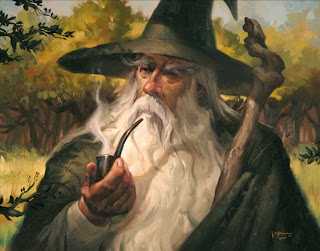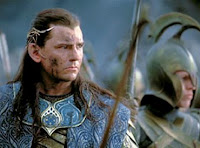Gandalf! If you had heard only a quarter of what I have heard about him, and I have only heard very little of all there is to hear, you would be prepared for any sort of remarkable tale. Tales and adventures sprouted up all over the place where he went, in the most extraordinary fashion.
––The Hobbit; Ch. 1: An Unexpected Party
It's impossible to imagine a Middle-Earth without Gandalf. Who would have booted Bilbo out his front door? Or rescued the Thorin & Co. from the clutches of the goblins? More importantly, who would have realized that Bilbo's small ring was actually the One Ring and had the foresight to start one small hobbit on a quest that would eventually lead to the destruction of the Dark Lord? The truth is, Middle-Earth would have been a very dark place without the Grey Pilgrim, yet few people––even among those who'd known the wizard longest––knew the full history of Sauron's greatest foe.
The Dark Years and the Coming of the Istari
 |
| Gandalf the Grey enjoying a bit of Old Toby |
Sauron feigned friendship with many of the peoples of Middle-Earth, but among the elves, only the Smiths of Eregion trusted him. Sauron taught these elves many things, and it was there in Eregion that the Rings of Power were forged. But in secret, Sauron forged the One Ring to dominate the other rings, and when the elven-smiths learned of the betrayal, war for the Rings of Power began. Eregion was razed and the High Elves that survived fled west to the lands of Gil-Galad. Sauron's might was great, but the elves were aided by the men of Númenor, and eventually the Dark Lord was captured and taken captive back to Númenor.
For long years Middle-Earth had peace, and Gil-Galad's realm spread for into the eastern lands, even beyond the Misty Mountains; however, on Númenor Sauron managed to subvert the Kings of the isle and their followers . . . eventually the island and all of the Númenoreans save Elendil and his family were destroyed. Sauron's body was destroyed, but his spirit fled back to Mordor.
 |
| Gil-Galad, last High King of the Elves |
The destruction of Sauron's body and the capture of the One Ring marked the end of the Second Age and the beginning of the Third. Arnor, the North Kingdom of the surviving Númenoreans soon fell into ruin and was eventually destroyed. For a while Gondor's strength grew, but then it too began to fade and the line of kings in the South Kingdom was lost. The realm of Gil-galad was no more and the High Elves could only be found now in two places: Rivendell where Elrond lived, and Lorien where Galadriel ruled. The dwarves were driven out of Moria by a Balrog, and the shadow of Sauron that had fled into the East quietly returned and crept into Mirkwood where it slowly grew and strengthened.
During these dark times when all good things seemed to be fading, the Valar––rulers of Middle-Earth and the western lands beyond the ocean––sent messengers to Middle-Earth to advise and aid the elves and men that still fought against Sauron. Coming in the form of old men, these messengers were called the Istari by the elves and wizards by men, and only five of them are known by name.
 |
| Sauruman the White, chief of the Istari |
 |
| Rhadagast the Brown, friend to fur and feather |
 |
| The Blue Wizards |
Last of all to arrive was Gandalf, who had been known as Olórin in Valinor. He was dressed in Grey and appeared older than the other wizards. Many mistook him for the least powerful of the five Istari, but Círdan the Shipwright who was there in the Havens when Gandalf arrived, recognized the power of the Grey Wizard, and gave him Narya, the Red, one of the Three elven rings of Power that he had kept hidden for many centuries.
"For," said [Círdan], "great labours and perils lie before you, and lest your task prove too great and wearisome, take this Ring for your aid and comfort. It was entrusted to me only to keep secret, and here upon the West-shores it is idle; but I deem that in days ere long to come it should be in nobler hands than mine, that may wield it for the kindling of all hearts to courage." And the Grey Messenger took the Ring, and kept it ever secret; yet the White Messenger (who was skilled to uncover all secrets) after a time became aware of this gift, and begrudged it, and it was the beginning of the hidden ill-will that he bore to the Grey, which afterwards became manifest.
––The Unfinished Tales of Middle Earth and Númenor; Part IV, II: The Istari
More than any of the other Wizards, Gandalf was the friend of the Elves, who called him Mithrandir, which means Grey Pilgrim. Throughout the Third Age, Gandalf would work with the Lords of the Elves––chiefly Círdan, Elrond and Galadriel––in the long fight against Sauron. In fact, Gandalf spent so much time with the Elves that many men mistook him for an elf, which is why men in the North of Middle-Earth began calling him Gandalf, which means "Elf of the Wand". In Gondor, far to the South, Gandalf was known as Incánus, or Greymantle, and among the dwarves he was called Tharkûn, or Staff-man. But of all these names, the wizard seems to have preferred the name by which he was known in the Shire: Gandalf.
The Grey Pilgrim



No comments:
Post a Comment